Clean Beef Cattle for slaughter: A guide for producers
This guidance booklet is intended for all involved in the beef supply chain, such as farmers, hauliers, veterinary surgeons, and abattoir and market operators. It aims to provide advice on the production of clean cattle for slaughter.
Producing clean cattle for slaughter can be a difficult task, due to wet-weather, long months of winter housing and straw-bedding cost/ supply. However, if hides are contaminated with dung at the time of slaughter, there is a very real risk of the meat becoming contaminated with harmful bacteria, such as E.coli O157, Campylobacter and Salmonella.
Even the highest standards of abattoir hygiene cannot guarantee to prevent contamination of the carcase and cross-contamination of nearby carcases during dressing. Research results have shown that the dirtier the hide, the greater the potential for carcase contamination and the higher the risk to human health. Wet hides may also increase the risk because bacteria may be transferred more readily.
On arrival at UK abattoirs, animals are assessed by the plant operator to determine whether they are clean enough to be slaughtered. The Food Standards Agency official* must verify that acceptable standards of cleanliness are used by the abattoir operator when sorting cattle so as not to compromise meat safety.
The operator may need to retain dirty animals in the lairage to be cleaned up, which can result in delay and extra costs for both producers and abattoir operators. It is both in the producersʼ and the abattoir operatorsʼ interest to make sure that cattle are clean when presented for slaughter. Appendix 1 details the legislation that is relevant to clean livestock at slaughter and is correct at time of publication.
Food safety hazards
E. Coli O157 and other harmful bacteria such as salmonella and Campylobacter can live in the digestive tract of cattle without causing them ill health, and may be shed in their dung. The carriage of harmful bacteria by herds or flocks is unable to be visibly detected by farmers or their vets. E. Coli 0157 is one particular type of E Coli, which has come to the forefront in recent years, because very small numbers can cause severe, even fatal, disease in humans.
*In Northern Ireland official supervision and enforcement in Approved Premises is carried out by Department of Agriculture, Environment and Rural Affairs (DAERA) on behalf of the Food Standards Agency.
Cleanliness at slaughter minimises the potential risk to human health, contributes to the production of safe meat, improves the shelf life of the meat, and consumer confidence.
In England and Wales the Disease Control Orders prohibit anyone sending animals to an abattoir unless they are to be slaughtered within 48 hours. This means animals must be clean enough for slaughter for food within 48 hours and cannot be returned if this is not achieved.
In addition, dung contamination causes irreparable damage to hides, which in 2004 was estimated to cost the British tanning industry £20 million per annum. Many tanneries are forced to import foreign hides, paying premium prices, which might otherwise be passed back to UK producers. Tanneries also select suppliers of hides by region.
This means that even if only a few local producers deliver cattle for slaughter dirty, all producers in the region will find it difficult to sell their hides to tanneries. UK farmers stand to benefit directly or indirectly from producing clean cattle. The consequences of delivering dirty cattle include:
- additional costs where dirty animals are retained in the lairage to be cleaned up at the abattoir
- cost of reduced slaughter line speed
- reduced carcass value due to excessive trimming
- reduced value of by-products – i.e. leather
- loss of the entire carcase
Operator decisions regarding cleanliness will include an assessment of the amount of dung and dirt present as well as the wetness of the hide.
A system of sorting animals into different categories, may be used to evaluate whether the animals are able to proceed to slaughter. Appendix 2 shows examples of cattle that have been assessed as being clean enough to proceed to slaughter and cattle too dirty, particularly if wet, to proceed to slaughter. These examples provide guidance for the levels of cattle cleanliness expected when they reach the abattoir.
Any animals that do not meet the abattoirʼs minimum requirements for cleanliness may need to be retained by the operator in the lairage to dry and will possibly need clipping or other treatment before they are slaughtered. There is also the possibility of cattle being rejected.
Extra time spent in lairage, clipping, reducing the line speed and rejection of animals all incur additional costs to producers and operators. Therefore it is in everyoneʼs best interests to make sure cattle are clean when presented for slaughter.
Cattle cleanliness is particularly affected by diet, housing, cattle health and weather conditions.
Using the advice in this booklet will aid in keeping cattle clean for slaughter, and the adoption of a Hazard Analysis Critical Control Point (HACCP) type of approach toward cattle management and production can reduce the risk of contamination further.
Finishing at grass
Grass-finished cattle are relatively clean, but wet summers and heavy, poorly drained soils can result in wet, muddy animals. Infection with gastrointestinal worms and grazing of young, lush grass increases the risk of scouring and dung contamination. Excessive use of nitrogen fertiliser and over-feeding minerals also causes cattle to be loose and dirty. In adverse weather and poor ground conditions, it may be necessary to house animals for a period before slaughter, to clean and dry them. Care is needed to minimise the risk of digestive upset and scour as a result of diet change at housing. Free access to straw or hay before and after housing is recommended.
The following should be considered when producing and finishing beef cattle from grass:
- plan an appropriate fertiliser programme before cattle are turned out
- plan an appropriate parasite- control programme with your veterinary adviser before turn out ( take care to comply with withdrawal periods for anthelmintics)
- provide free-access to straw or hay when stock are on lush grazing during prolonged wet weather and before and after housing
- move ring feeders and creep feeders frequently to avoid poaching and muddiness
- treat specific mineral and vitamin deficiencies known to occur in your herd and avoid routine free-access supply of general purpose supplements
- supply magnesium to susceptible stock only during risk periods
Diet
Silage-based diets and roots
Silage-based diets and roots produce the greatest likelihood of visible dirtiness because they result in large quantities of wet dung.
Good digestibility and protein content of silage are required for good production performance, but to minimise the likelihood of dirty cattle:
- use appropriate amounts of fertiliser on silage fields and do not apply fertiliser within six weeks of the expected cutting date
- wilt the silage well when weather conditions permit
- have silages analysed in advance of feeding. This may allow you to ear-mark the most suitable silages for finishing groups and young calves
- use analysis to balance protein and energy levels correctly in the ration
- provide cattle with free access to straw feed from a ring feeder or trough (not just from the bedding).. Alternatively include long-chopped straw in a mixer waggon rations
- add sodium bicarbonate to rations containing acidic silage
Hay-based diets
Hay-based diets produce relatively clean cattle, but are rarely an option for high performance finishing animals, because of the low nutrient value.
Intensive cereal diets
These rations produce small quantities of high dry matter dung and therefore cattle appear generally clean. However, health problems, including scouring, can occur if an intensive cereal diet is introduced or changed too rapidly, if it is nutritionally unbalanced, if there is a lack of long fibre in the diet, or if cereals are too finely ground.
- ensure the ration is correctly balanced for protein, energy, minerals and vitamins
- provide free access to straw fed from a trough or ring feeder (not just from the bedding)
- use cereals which have been lightly rolled, not finely ground
Other dietary factors
Overfeeding minerals, particularly magnesium and salt, increases the risk of dung contamination of the hide by causing mild scouring and increased urine production. Access to minerals and salt should be restricted as cattle have a tendency to eat more than they need. Caustic soda treatment of grain and straw increases sodium intake and urine production and can cause a mild scour, increasing the risk of dirtiness.
Abrupt feed changes can lead to digestive upset, scouring, poor cattle performance and dirtiness.
Aim to:
- feed minerals formulated accordingly to the type of diet and at levels appropriate to the type of stock
- avoid feeding free-access minerals or slat licks
- avoid caustic soda-treated feeds for finishing rations
- always make diets changes gradually
Housing
In the UK, the highest rejection rates for dirty cattle at slaughter occur from October to April. Poor housing design and management are significant contributory factors. It is more difficult to keep cattle clean in slatted yards than straw-bedded yards, but a well-managed slatted system can produce cleaner cattle than a poorly managed straw yard.
General building design
Good ventilation, drainage and aspect are important considerations for a good cattle building. Humidity and condensation in poorly ventilated buildings result in dirtier cattle. Uneven floor surfaces, poor drainage and leaking roofs, gutters and water troughs also cause wet, dirty hides. Aim to achieve the following:
- cattle housing well ventilated
- concrete flooring sloped sufficiently to allow adequate drainage and dirty water from these areas removed prevent pollution travel to keep
- floors free of pot-holes, and roofs, guttering and water troughs well maintained
- feed trough raised about bedding height, or solid low level feed barriers set at a suitable height above the floor, to avoid dung contamination of feeds
- fully enclosed yards sited with the longitudinal axis running north-south
- open-fronted yards facing south or south-east
Slatted yards
Both over-stocking and under-stocking limit the treading of dung through the slats and result in dirtiness.
Small cattle should be kept in a smaller area (tighter) initially, and given more space, according to their size, as they grow.
When animals are removed for slaughter, the space for the remaining cattle needs to be reduced. It may be possible to combine groups of steers or heifers, although mixing should be avoided where possible, particularly in groups close to slaughter.
For bulls, the pen size should be reduced with moveable gates. Unfamiliar animals in particular bull groups should not be mixed due to the disturbance and aggression this causes, which in itself will cause dirtiness as well as reduced performance and an increased risk of injury.
Feed space allowance is a further consideration.
When a fixed - ration is provided to cattle, sufficient space at the feeder should be available for all animals at any given time and this may prevent the correct stocking rate being achieved. Animals fed DG OLELWXP do not require as much feed space access (minimum 50% at any given time) Optimum stocking rates and feed space allowances are given in Appendix 4.
Aim to achieve:
- stocking rates appropriate for the size of cattle
- slurry storage and frequency of the removal adequate to prevent blocked slats
- solid floor areas at the end of the slats are sloped to minimise dung build up
- nipple-drinkers in preference to water troughs because they minimise obstructed areas where dung can collect
- bottom rails of gates and pen divisions 200-250mm above the floor
- moving cattle to a straw-bedded “marketing yard” as they approached finished condition if they require cleaning up
- not mixing animals from different groups
- keep mixing to a minimum toward the end of finishing
Straw-bedded yards
Overstocking, insufficient bedding or infrequent bedding-up are the main reasons for dirtiness in straw-bedded yards.
Extra straw provision will not compensate for overstocking. Straw shredders allow quick, even bedding-up, but research has shown that adequate amounts of straw must be used if animals are to be kept clean.
Large wood chips can be considered as an alternative material to straw for bedding finishing cattle. Animals tend to defecate and urinate more in the loafing/feeding area, which often becomes very wet and dirty in completely bedded yards. It is therefore preferable to provide a clear concrete standing that is easily kept clean.
Aim to achieve:
- space allowance appropriate for the size and number of cattle Optimum allowances are given in Appendix 4
- frequent bedding up with adequate straw to ensure cleanliness
- a clean loafing/feeding area and scrape regularly
- bedding straw stored under cover, wrapped or well covered with plastic sheeting, and stacked on a free draining site
Cubicle housing
Cubicles are not recommended for growing and fattening cattle as the cubicle size required increases as the animal grows. If cubicles are too small, cattle tend to lie in dirty passageways, whereas over- large cubicles allow animals to defecate on the bedding. Both problems lead to dirtiness.
Cattle health
Any disease or disorder that causes scouring increases the risk of a dirty hide. Sweaty animals also become dirty more easily. In addition, any illness reduces the animal’s overall resistance to disease; so sick cattle are more susceptible to other infection, for example E.Coli and Salmonella.
Therefore, good general herd health management is important in reducing the risk of cattle carrying pathogenic organisms at slaughter, which could lead to food poisoning in humans.
A good, all-round preventative farm health plan should include:
- a well balanced diet
- prevention of coccidiosis and salmonellosis by good hygiene and appropriate veterinary medicine usage
- appropriate worming at housing to prevent over-wintered ostertagiasis (ivermectin-type wormers have to added benefit of controlling external parasites)
- prevention of copper deficiency – a common cause of scouring
- an appropriate supply of mineral/vitamin supplements that are correctly balanced
- prevention of pneumonia
- good general hygiene and stockmanship
Clipping cattle at housing
Clipping the backs of finishing cattle at housing (approximately 5 cm each side of the spine) helps to reduce sweating and the risk of wet, dirty hides. Tails should be trimmed at housing to avoid dirt being flicked over the hide.
If it is necessary to trim dirty hair on the belly and flanks of cattle, clipping should be delayed until the animal is ready for slaughter. Animals marketed from March onwards are likely to shed any long hair, and any adherent dirt, naturally.
Clipping has been shown to remove visible dirt before slaughter, but trimming these areas earlier can mean that dirt subsequently becomes ingrained close to the skin where it is more difficult to loosen. When clipping great care is needed to prevent injury to farm staff or animals, and should only be undertaken if adequate facilities and equipment are available.
The Health and Safety Executiveʼs (HSE) Agriculture Information Sheet No 35 outlines safe clipping practice. See Appendix 5.
- clipping at housing should only be carried out when required to prevent animal sweating (5cm each side of the spine)
- clipping to clean-up for slaughter should be carried out as a close to the slaughter date as possible
- tails should be kept trimmed
Clearly, the aim should be to prevent animals becoming dirty in the first place, but some degree of cleaning prior to slaughter may be necessary (refer to Appendix 1 for Regulations).
Numbers of dirty cattle presented to UK abattoirs decline from March onwards, as cattle naturally shed the winter coat and any dirt they may be carrying. However, some native British breeds tend not to shed the long winter coat as early as other cattle, and are therefore more likely to require attention before slaughter.
For cattle finished on silage, roots, brewers grains etc., consider changing to a drier ration, e.g. a cereal-based ration, as cattle approach finished condition. Inspect every animal regularly during finishing and before it leaves the farm, using the examples in Appendix 2.
Clipping may be necessary, or cattle may self-clean sufficiently if moved to a “marketing yard” with adequate bedding. Research has shown that cattle fed on straw and water only, for up to 36 hours before transporting to slaughter, have reduced dung contamination during transport. Some retailers now require this method of feeding. This period should not be prolonged as there is no additional benefit for increasing this time period beyond 48 hours.
Avoid washing finished cattle before slaughter. The hide must be completely dry before the animal leaves the farm as hide moisture has been linked to an increased level of bacteria recovered from the hide. Never use a power hose to clean cattle. This is distressing for the animal and likely to cause bruising and reduced carcase value.
- assess finishing cattle cleanliness and take appropriate action
- consider finishing diet
- use a straw-bedded ‘marketing yard’ (see below) for dirty cattle
- achieve dry hides
The Marketing Yard
If cattle need to be cleaned up prior to slaughter, they may need to be moved to a marketing yard. A marketing yard should provide the best possible conditions to encourage cattle cleanliness: adequate supplies of good quality straw bedding and sufficient space allowance (see Appendix 4). Ideally, such conditions should exist in the usual finishing pens. Animals that are simply wet or slightly dirty may then be fit for market within a day or so, but if cattle are very dirty they could require 3 to 4 weeks to clean up in an adequately bedded yard. Evidence shows that mixing groups of animals increases the risk of contamination transfer and should therefore be kept to a minimum.
Research has also shown that bacteria can survive well in livestock environments, so ideally the area should be cleaned and disinfected before a new group of animals is introduced. Good housing design and management that will encourage cleanliness are obviously important.
- ensure sufficient time is allowed within the marketing yard for animals to clean up
- provide adequate bedding
- house cattle at the correct stocking density
- provide a suitable diet - sudden changes in diet will cause a digestive upset
Clipping cattle prior to slaughter
If cattle remain dirty, it may be necessary to clip them just prior to slaughter to clean them up. Remove excessive dirt by clipping, particularly on the brisket, flanks, belly, legs, knee and hock joints (areas from which the risk of contamination transfer to the carcase is high).
Great care is needed during clipping to avoid injury to the animal or to staff. Further guidance for clipping is given in the Health and Safety Executive (HSE) Agriculture Information Sheet No 35 (Appendix 5), which should be read and understood before undertaking clipping.
- use well maintained clippers with ab appropriate comb to prevent nicking the skin
- wear suitable protective clothing: a hard hat and steel-capped boots
- use a circuit breaker and do not clip wet cattle
- cattle should be securely restrained in an appropriate crush – see HSE Agriculture Information Sheet No 35 in Appendix 5
- remain calm, quiet and confident throughout the whole clipping-process
- begin clipping on a clean area of the back, to accustom the animal to the noise and feel of the clippers, before moving to the belly and legs
- be prepared to clip particularly dirty animals over a number of days to avoid unnecessary stress to the animal
Post slaughter clipping, or other post-mortem cleaning methods, can be used at the abattoir providing the operator can demonstrate that the clipping or cleaning procedure effectively controls any food safety risks that may arise.
This means, for example, controlling risks from the hair and dirt that could be mobilized in the procedure and ensuring that a clipped or cleaned hide is clean enough so that unacceptable contamination of the carcass during dressing does not occur.
Transporting finished cattle
Vehicles should be cleansed and disinfected between loads to prevent survival of bacteria and disease according to any current legislation, such as The Transport of Animals (Cleansing and Disinfection) (England) (No 3) Order 2003*, and the relevant Disease Control Order.
Equivalent regulations in NI and Wales apply. Farmers and haulers should check with their local Agriculture Department office for advice on current biosecurity regulations. Stocking rates should follow the recommendations of the assimilated Council Regulation (EC) 1/2005, Annex I, Chapter VII and allow some animals to lie down safely. Partitions should be used, where appropriate, to prevent injuries as a result of under-stocking.
Adequate bedding should be provided as clean fresh straw. Sawdust should be avoided as it adheres to hides and may cause problems when the carcass of the animal is dressed.
Journey time and distance should be in accordance with the requirements of the assimilated Regulation (EC)No. 1/2005 on the protection of animals during transport and related operations.
*Transport of Animals and Poultry (Cleaning and Disinfection Order (Northern Ireland) 2007. The Transport of Animals (Cleansing and Disinfection) (Wales) (No. 3) Order 2003. In Northern Ireland EU law continues to apply as listed in the Northern Ireland Protocol.
Evidence suggests visible and bacterial cleanliness declines with increasing transport time and distance.
It is advisable to modify the diet, or to withdraw food for a short time before transport, to reduce faecal soiling.
Feeding a straw diet for 1-2 days prior to transport has been shown to be beneficial. When animals are transported to market or slaughter the following points should be considered:
- use a reputable haulier/transporter
- consider pre-transport diet
- vehicles clean, disinfected and well ventilated
- adequate clean and fresh straw bedding
- animals dry at loading and kept dry throughout, up to the point of slaughter
- mixing animals avoided
Owners and those looking after cattle have a legal responsibility to protect the welfare of animals at all times.
The retained EU Food Hygiene Regulations (EC No. 852/2004, EC No. 853/2004 and EU 2019/627) emphasise every food business operatorʼs (including abattoir operatorʼs) responsibility to produce food safely by applying good hygienic practices and food safety management procedures based on hazard analysis and critical control point (HACCP) principles.
Retained EC Regulation 852/2004 (H1) requires food business operators rearing animals to, as far as possible, ensure the cleanliness of animals going to slaughter and, where necessary, production animals. Retained EC Regulation 853/2004 (H2) provides the hygiene control requirements for slaughter and states that all animals should be ʻcleanʼ before being accepted onto the slaughterhouse premises.
Retained EU Regulation 2019/627, article 11, paragraph 4; also refers to the Food Business Operator's obligation to ensure that animals have a clean hide so as to avoid any unacceptable risk of contamination of the fresh meat during slaughter.
Northern Ireland
This images shows a cow with little dung/dirt visible. Very minor amounts of loosely adherent straw/bedding.
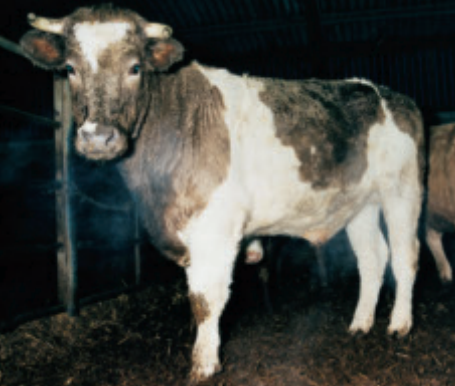
Dry animals appearing similar to, or cleaner than, the examples given below are considered to be clean enough to proceed to slaughter.
Below is a cow with Light contamination with dirt/dung Small amounts of loosely adherent straw/bedding.
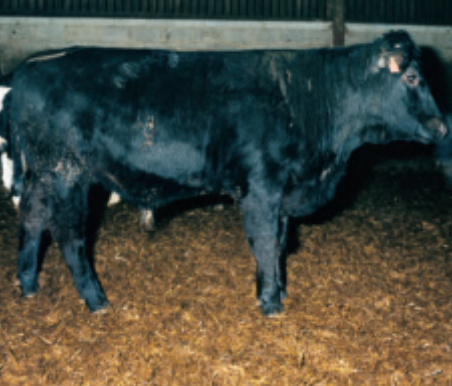
Animals that are dirtier than the examples below, particularly if they are wet, are likely to require extra attention at the abattoir. If the abattoir operator has to hold animals prior to slaughter or slow the line or take other additional measures, additional costs will be incurred.
Below is a damp or dry cow showing significant contamination with dirt/dung and/or significant amounts of adherent straw/bedding.
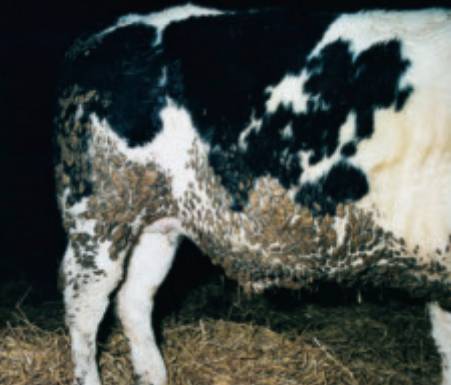
Below is a cow which is damp, heavily contaminated with dirt/dung, heavily clagged (clegged) and with significant amounts of adherent bedding.
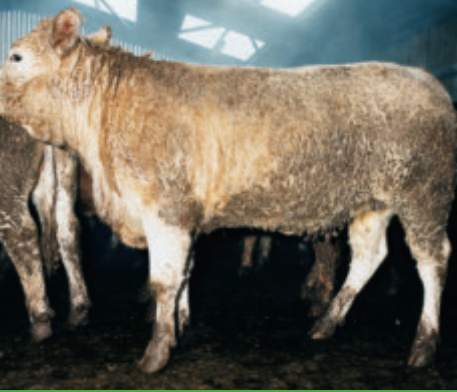
Below shows a cow which is clearly very wet, very heavily contaminated with dirt/dung and very heavily clagged (clegged). A lot of bedding is adherent to the coat.
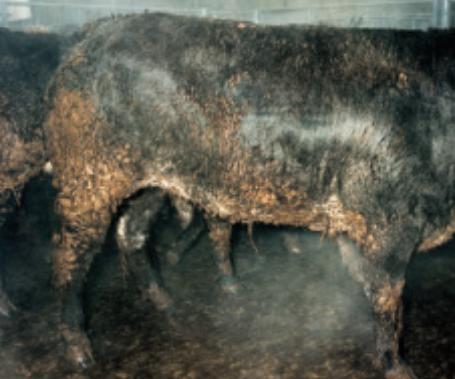
In a HACCP system, all potential hazards to food safety at each stage of the production chain are identified. A Critical Control Point (CCP) is a point, step or procedure where control must be applied to prevent, eliminate or reduce a food hazard to an acceptable level. To assure food safety, each CCP is monitored to check that it is within critical limits.
If limits are in danger of being broken, corrective action must be taken. This systematic approach, if properly implemented, should ensure the safe production of food.
The seven principles of a HACCP system are:
- conduct a hazard analysis and develop production flow charts
- identify the CPP’s
- establish critical limits i.e. set target levels which must be met ti ensure the CCP is under control
- establish a system to monitor control of the CCP
- establish corrective actions to be taken when monitoring indicates that a CCP is not under control
- establish procedures for verification to confirm that HACCP system is working correctly
- establish documentation/records for all procedures
- (Advantages of using a HACCP style approach:
- proactive in identifying food safety hazards before they occur
- maximise product safety i.e. Clean cattle
- non-destructive
- provides evidence of due diligence
- cost effective
- safety assurance involving all staff
Table 1: Space allowances on fully slatted floors and trough space requirements
Trough Space (mm/head)
| Live weight of animal (kg) | Area (excluding troughs) (m2/head) | Restricted feeding | Ad lib feeding |
|---|---|---|---|
| 200 | 1.1 | 400 | 100 |
| 300 | 1.5 | 500 | 125 |
| 400 | 1.8 | 600 | 150 |
| 500 | 2.1 | 600 | 150 |
| 600 | 2.3 | 600 | 150 |
Table 2: Space allowances in bedded yards
| Live weight of animal (kg) | Bedded area (m2/head) | Loafing/feeding area (m2/head) | Total area |
|---|---|---|---|
| 200 | 2.0 | 400 | 100 |
| 300 | 2.4 | 500 | 125 |
| 400 | 2.6 | 600 | 150 |
| 500 | 3.0 | 600 | 150 |
| 600 | 3.4 | 600 | 150 |
Sources:
1. Farm and Rural Buildings Pocketbook (1991)
The Animal Welfare Act 2006 and the Welfare of Farmed Animals (England) Regulations 2007 (S.I. 2007 No. 2078) (footnote 1) , make it an offence to cause or allow unnecessary pain or distress.
Dung contamination of the hide compromises the animalʼs welfare by causing skin damage, pain and the risk of infection. In addition, animals that are presented in a dirty condition may be lairaged to clean up. This additional handling may cause unnecessary stress to the animal.
The Welfare of Farmed Animals (England) Regulations 2007 (footnote 2) requires livestock to be provided with an adequate supply of fresh drinking water each day and to have access to food each day.
The diet must be wholesome, appropriate to the species, and fed in sufficient quantity to maintain good health and to satisfy nutritional needs.
Where any livestock, other than poultry, are kept in a building, they shall be kept on, or have access at all times to, a lying area, which is well drained or well-maintained with dry bedding (The Code of Recommendations for the Welfare of Livestock - Cattle)
- animals shall be fed a wholesome diet which is appropriate to their age and species, and which is fed to them in sufficient quantity to maintain them in good health and to satisfy their nutritional needs and to promote a positive state of wellbeing.
- all animals shall either have access to a suitable water supply and be provided with an adequate supply of fresh drinking each day or be able to satisfy their fluid intake needs by other means. There should be enough water available for at least 10% of housed cattle to drink at any one time.
- grazing animals should have access to appropriate number of water troughs (large enough and of the right design) or some other source of drinkable water that the animals can readily use wherever they are grazing
- feeding and watering equipment shall be designed, constructed, placed and maintained so that contamination of food and water and the harmful effects of competition between are minmised
- all concrete yards of passageways should be kept in good condition. Where slatted floors are used, you should pay attention to the type of slots, to avoid slipperiness. You should only use slotted pens of size animal that they designed for, and part of the accommodation should be a solid- flow with some other suitable bedding material
- where any animals are kept in a building they shall be kept on, or have access at all times to, a lying area which either has a well-maintained dry bedding or is well-drained
- air circulation, dust levels, temperature, relative humidity and gas concentrations shall be kept within limits that are not harmful to the animals
- bulls reared for slaughter should be kept in small groups, preferably of not more than 20 20 animals. Bulls should not normally be added to groups already formed, and neither should one group of bulls be added to another to send to slaughter. Groups of bulls should be kept at a safe distance from female cattle.
- planning the grazing rotation and using effective medicinal products or vaccines control internal parasites. Animals should be treated for parasites with the veterinary surgeons advice